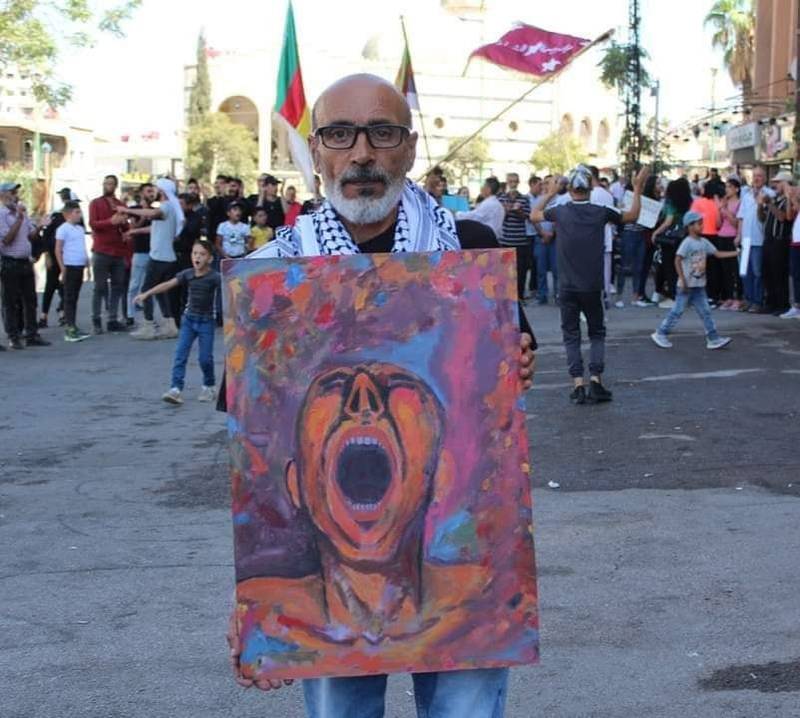By : Khaled Yacoub Oweis
In the Syrian desert in the third century, an enigmatic queen defied Roman rule and was defeated after several years of independent reign.
Her name was Zenobia.
She is being reincarnated in demonstrations against President Bashar Al Assad in the south-western province of Sweida, near the border with Jordan.
The protest movement, which is in its second month, has been unprecedented in the 53-year rule of the Syrian President and his late father, in that it has not been met by a crackdown from the authorities.
Young women in a Zenobia queen uniform of yellow and blue marched in the provincial capital of Sweida several days ago, among men wearing red, symbolising the queen’s centurions, and carrying placards.
“All civilizations condemn you,” read one, in reference to the President.
:quality(70):focal(900x587:910x597)/cloudfront-eu-central-1.images.arcpublishing.com/thenational/ZFLVEYYAIREFFNJ2WYNQEV55Z4.JPG)
The colourful display represents the spread of art as protest in the struggle against Mr Assad in the mostly Druze governorate.
Another placard called for saving Sweida “from sabotage”.
The city, a once picturesque rural centre amid a basalt rock landscape, has been marred by concrete buildings and other architectural trappings of the government’s Soviet-like rule since the 1960s.
:quality(70)/cloudfront-eu-central-1.images.arcpublishing.com/thenational/DOS7LNULIRGTRBGJIU6SZNQNBM.jpg)
In the near by Roman-era city of Shehba, a woman in a Zenobia queen outfit welcomed protesters as they entered a Roman theatre in the city for a sit-in this week.
The demonstrations have been peaceful, although regime loyalists reportedly shot and wounded three young men last month, when they tried to close a ruling Baath party office in Sweida.
Sana Yazigi, head of the Creative Memory documentation organization, says the lack of a violent regime response to the street movement has contributed to a rapid expansion of artistic political expression in Sweida.
She pointed out songs and dance at the city’s main square, as well as studio-quality videos of songs denouncing Mr Assad that have been recorded in Sweida since the protests started on August 20.
“The emphasis is on the non-violent nature of the uprising, which is crucial to countering any potential excuse for the regime to use force against Sweida,” Ms Yazigi says.
Art as protest
Her organisation has documented art as a tool of civil disobedience since the outbreak of the Syrian revolt against the President in 2011.
Within months, security forces crushed street protests, which mostly comprised members of the country’s Sunni majority. By the end of the year, the revolt had become militarised.
A takeover by extremists of the rebel movement contributed to keeping the Druze and other minority communities on the sidelines, or on the side of Mr Assad, although some of them had participated in the initial demonstrations.
A deterioration of economic conditions in 2019 promoted renewed demonstrations in Sweida. But they were directed against the government, not the President.
:quality(70)/cloudfront-eu-central-1.images.arcpublishing.com/thenational/IL226HLTJRBAZIVJF72K4MF4RE.jpg)
One of the messages behind the revival of Zenobia is that “this regime does not have a monopoly of Syria’s heritage”, says Ms Yazigi, who grew up in Sweida and now lives in exile in Paris.
Among the leaders of the political art movement is Suhail Thubian, a sculptor who spent six years as a political prisoner under Hafez Al Assad’s rule.
He has been detained intermittently since Bashar Al Assad became President in 2000.
Mr Thubian is working on drawing black and white posters that depict prisoners who disappeared in Mr Assad’s jails.
:quality(70)/cloudfront-eu-central-1.images.arcpublishing.com/thenational/INQNSLEC7BGM7KJJG2IMJKJO2A.jpg)
Their release has been a constant theme of the pro-democracy protests in Sweida, as well as demands to implement UN resolutions for political change in Syria.
At one demonstration, Mr Thubian carried a painting of a screaming prisoner, painted in red. It was drawn by Mulhem Al Abatha, another artist and former political prisoner from the Ismaeli area of Musyaf in the north of Syria.
Their friend Ali Nayyouf staged an impromptu exhibition of his works at the main square of Sweida, the centre of the street movement in the governorate.
“The art is a reflection of our peaceful struggle and of who we are: civil people who deserve to live,” says Mr Thubian.
The National


Leave a Reply
You must be logged in to post a comment.